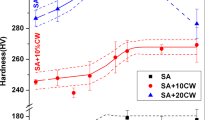Conclusions
-
1.
The fatigue limit and the low-cycle fatigue strength of precipitation-hardening steels after strain hardening and high-temperature tempering are three times higher than for ordinary carbon steels subjected to the same treatment.
-
2.
The high cyclic strength after this treatment is due to the substantially lesser tendency of precipitation-hardening steel to relax first-order compressive stresses in the surface layer during cyclic tests and the stability of the substructure.
-
3.
The combination of precipitation hardening, surface hardening, and repeated hightemperature tempering makes it possible to obtain a heat-resistant material (400–450°) with a fatigue limit (at room temperature) around 100 kgf/mm2.
Similar content being viewed by others
Literature cited
A. N. Marshalkin and Yu. A. Kulakov, ,“Increase in the fatigue strength of structural steel,” Byull. TsNIIChERMET, No. 12, 48 (1973).
Ya. S. Umanskii, X-Ray Analysis of Metals and Semiconductors [in Russian], Metallurgiya, Moscow (1969), p. 313.
I. V. Kudryavtsev, Surface Hardening to Increase the Strength and Fatigue Limit of Machine Parts [in Russian], Mashinostroenie, Moscow (1969), p. 21.
P. I. Kudryavtsev, ,“Increase in the strength of machine parts due to surface hardening,” in: Transactions of the Central Scientific-Research Institute of Heavy Machine Construction [in Russian], No. 110, Mashinostroenie, Moscow (1969), p. 54.
A. N. Marshalkin and Yu. A. Kulakov, ,“Effect of substructure on changes in the properties of steels with secondary hardening during tempering, Izv. Vyssh. Uchebn. Zaved., Metall., No. 9, 121 (1974).
V. S. Ivanova, L. I. Maslov, and L. R. Botvina, ,“Fractographic characteristics and fracture toughness of steel during cyclic loading,” Probl. Prochn., No. 2, 37 (1972).
Additional information
Moscow Evening Metallurgical Institute. Translated from Metallovedenie i Termicheskaya Obrabotka Metallov, No. 6, pp. 54–57, June, 1977.
Rights and permissions
About this article
Cite this article
Marshalkin, A.N., Kulakov, Y.A. Cyclic strength of precipitation-hardened steel after strain hardening and high-temperature tempering. Met Sci Heat Treat 19, 478–480 (1977). https://doi.org/10.1007/BF00713087
Issue Date:
DOI: https://doi.org/10.1007/BF00713087




